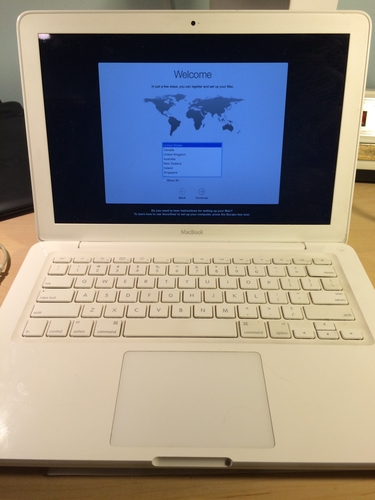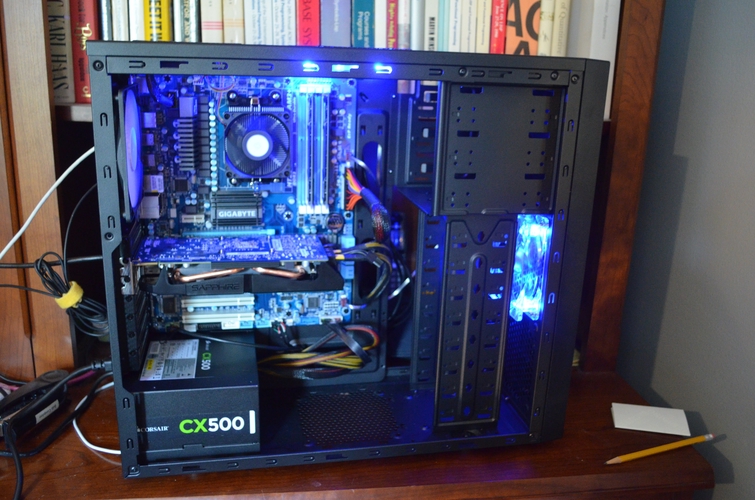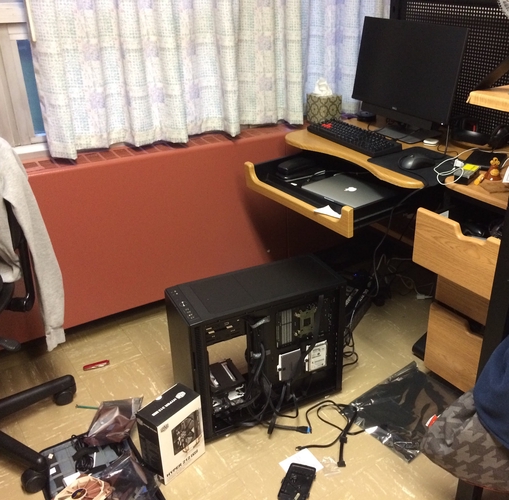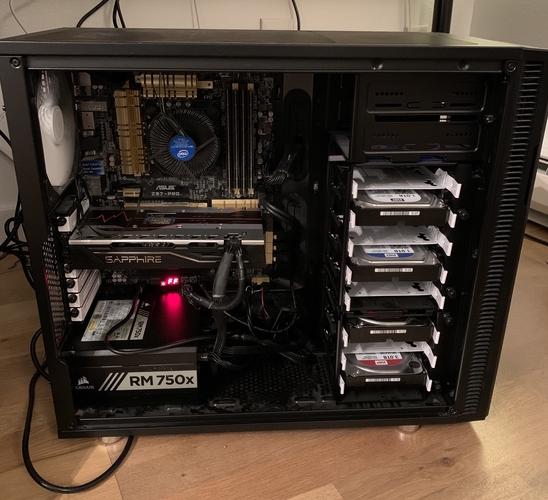Over the last couple months, I’ve been rebuilding my desktop tower into something resembling a gaming machine. Over the weekend, I finally installed Windows on an old SSD and booted it up. When I reconnected the hard drives that have been sitting in antistatic plastic bags for several years, I found my collection of Steam games and other digital detritus still in tact.
It dawned on me that I’ve been using this machine, in one way or another, since 2013. After rebooting it this weekend into its original purpose as a gaming machine, I began to reflect a bit on the various forms it’s taken.
Humble Beginnings
Back in 2013, when I was in high school, my primary computer was a White Plastic Macbook. It had something like 256MB of VRAM, which was just barely sufficient to play Team Fortress 2 and Minecraft on mediocre settings. After years of dual-booting into Windows via Boot Camp, I got fed up and planned to build my own PC.

Now that’s what I call a laptop
After making some money from my first summer job, I researched PC components for weeks. Eventually, I put together a fairly performant but otherwise unremarkable gaming PC. It was loud, hot, and consumed a frightening amount of power: I’d skimped on a efficient PSU and had built the thing in almost the cheapest case I could find (well, it still needed to have a side window so I could see all the cool internals – I wasn’t a monster).

Blinded by Blue LEDs
I used that machine as my daily driver for my last 2 years of high school. During that time, I bought buying a second monitor and a bunch of tacky Gamer™ accoutrements: wireless headset with folding mic? Check. Gaming mouse with oversized mousepad? You betcha. Looking back, it was a fun setup that I managed to pull together on a shoestring budget.
I even mined some DOGE coin on my underpowered GPU. I almost certainly cost my parents more in power than it ever mined, but spontaneously creating $20 of internet money was incredibly exciting to me at the time.
College Rebuild
When I moved to Illinois for college, I did some rough math and concluded that shipping my PC to college would probably cost more than it was worth (literally). So, I partially rebuilt my PC: I kept the GPU and hard drives, but bought a new case, PSU, CPU, and motherboard.
Assembling my rebuilt desktop was pretty much the first thing I did in my dorm room after moving in.

However, over that summer I’d received a Macbook Pro as a “going to college” present from my parents. Despite me being firmly in the Windows camp at that point, my new Macbook would eventually dethrone my desktop. As I was getting more into programming as a daily practice, I began to see Windows as an unnecessary roadblock. The common wisdom for CS coursework at my school was to either (1) use a Mac or (2) run a Linux VM. I had a Mac, and was really starting to enjoy using it.
At the same time, my interest in video games was waning. The 2 major games I played in my freshmen year of college were Fallout 4 and Metal Gear Solid V. The “evergreen” games I’d played so much in highschool – Garry’s Mod, TF2, and CS:GO – became less interesting to me. Throughout my time at college, working on personal projects supplanted the time I would have spent playing video games, and so my desktop got less and less use.
Decay and a new Purpose
When I moved into an apartment for my sophomore year, I had to reconsider whether or not to keep my desktop. For it to “earn” its place under my desk, it had to serve some purpose. So, I bought some NAS-grade hard drives and a license for UnRAID and converted it into a home server. It was great for this purpose: I used it to host a Plex instance, store a backup of my family’s photo collection, store backups of my Laptop, and run various cron jobs, docker containers, and VMs.
And… for ~3 years that was pretty much all that I used my desktop for. I eventually soured on UnRAID; the core OS was stable, but it’s plugin ecosystem rotted over time. UnRAID’s forums tended to be unhelpful, or recommend extreme “solutions” to mundane problems (No, I’m not going to reconfigure my entire server because a Docker container ran into a minor permissions issue). I still use UnRAID, but it isn’t something that I’d enthusiastically recommend.
An Unplanned Rebuild
After I graduated college, I was again faced with the decision to ship or scrap my desktop. It was still pretty useful to me as a home server, so I shipped the case, motherboard, CPU, and drives back to Seattle. I donated my GPU (which was woefully underpowered at this point) to my school’s ACM group.
When I moved into my apartment in Seattle, I started to rebuild the machine. However, in transit one of the fragile motherboard pins had gotten bent. Ironically, I’m pretty sure the pin got bent when I was installing the CPU socket cap – which is ostensibly supposed to prevent such issues. I tried bending the pin back into place, but… it never booted.
My CPU was old enough at this point that you couldn’t buy a new motherboard that supported it. Fortunately, I was able to buy a used motherboard on Reddit. By sheer luck, I hadn’t damaged my CPU in transit or during the process of discovering the damaged motherboard. Everything worked fine with the replacement parts.
Last week, I felt inspired to reconnect with my Steam library, so I bought a RX 580, plugged it in, and setup a new Windows 10 install. It’s not top-of-the-line by 2020 standards, but it absolutely rips through my circa-2015 game collection.

Not pretty, but it works
Currently, my desktop is a part time gaming machine / home server that I dual boot. I’m looking into moving the “server” responsibilities to a Raspberry Pi 4. My server needs are mostly mass storage and lightweight periodic tasks, so I’m hopefully I can offload that work to a Raspberry Pi.
At this point, the only remaining original parts from the first build of my desktop are 2 1TB hard drives that I bought to hold my Steam collection (which, at this point should probably be replaced). Once those drives fail, it’ll be a true desktop of Theseus.
There’s something intangibly cool about building and maintaining a desktop computer. I don’t get the aesthetic joy from LEDs or water cooling loops that other PC builders express, but I do like the sense of control and the “homemade” feeling of accomplishment you get by assembling your own machine.